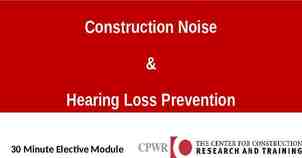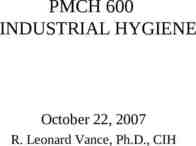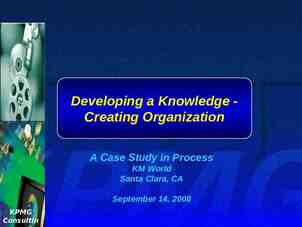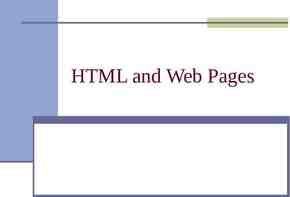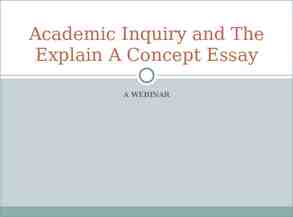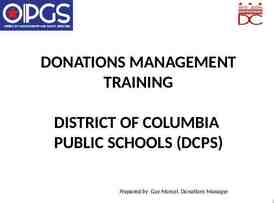Econ 340 Lecture 24 Review
91 Slides377.47 KB

Econ 340 Lecture 24 Review

Lecture 24 Outline For each lecture: Outline Major questions Lists of – Terms – Acronyms (most are really Initialisms) Clicker questions – Especially on graphs Econ 340, Deardorff, Lecture 24: Review 2

Lecture 1: Overview of the World Economy Overview of the World Economy “Globalization” Elements of the World Economy Ways that Countries Interact – Trade – Capital Flows – Migration Policies that Affect Others Institutions Econ 340, Deardorff, Lecture 24: Review What are the elements of the world economy? How have they changed? Who trades the most? Who trades with whom? 3

Lecture 1: Overview of the World Economy Terms – – – – – – – – – – Acronyms Globalization Openness Gross domestic product Regional trade agreement Capital flow Shallow integration Supply chain Emerging market Beggar they neighbor Bretton Woods – – – – – – – – – CIA IMF WTO GATT IBRD FDI RTA NAFTA SDR Econ 340, Deardorff, Lecture 24: Review 4

Clicker Question Where does the largest share of Michigan’s imports come from? a) b) c) d) Canada China Mexico European Union 5

Clicker Question Compared to the 1940s, US tariffs today (as of 2017) are? a) b) c) d) e) Higher About the same, on average Half as large Only about 1/10 as large Gone 6

Lecture 2: Current Tensions in the International Economy NAFTA Brexit Trade War – Metals – China – Other? WTO Currencies What “tensions” do these refer to? What tariffs were levied? On what? On whom? How big? What tariffs were threatened but not (yet) levied? Econ 340, Deardorff, Lecture 24: Review 7

Lecture 2: Current Tensions in the International Economy Terms – – – – – – – – – – – – Acronyms Rules of origin Brexit (& No Deal Brexit) Hard border Irish backstop Trade war Truce National security Developing country Appellate body Currency manipulation Joint venture Section 301 – – – – – NAFTA ROOs USMCA EU WTO Econ 340, Deardorff, Lecture 24: Review 8

Clicker Question What is a Rule of Origin? a) b) c) d) e) A prohibition on employing illegal immigrants A requirement for registering to vote A restriction on who can invest in a country A specification of what qualifies for zero tariff A law against exporting imitations Lecture 2: Tensions 9

Clicker Question What reason is given for Trump’s tariffs on China? a) b) c) d) e) That imports are hurting US producers National security Unfair acquisition of intellectual property Dumping China’s trade surplus Lecture 2: Tensions 10

Clicker Question What reason is given for Trump’s threatened tariffs on cars? a) b) c) d) e) That imports are hurting US producers National security Unfair acquisition of intellectual property Dumping China’s trade surplus Lecture 2: Tensions 11

Lecture 3: Comparative Advantage and the Gains from Trade Why Countries Trade – Price Differences – Supply and Demand – Determinants of Prices Ricardian Model of Trade – Examples – Wages and Prices in the Ricardian Model – Lessons from the Ricardian Model Generality of the Gains from Trade Identifying Comparative Advantage Critiques of Comparative Advantage Econ 340, Deardorff, Lecture 24: Review How do you define comparative advantage? How does Ricardian theory reassure a low-productivity country? How does Ricardian theory reassure a high-wage country? 12

Lecture 3: Comparative Advantage and the Gains from Trade Terms – – – – – – – – – – – Absolute advantage Comparative advantage Opportunity cost Consumer surplus Producer surplus Productivity Trade adjustment assistance Autarky Ricardian model Protection Mercantilism Econ 340, Deardorff, Lecture 24: Review 13

Clicker Question For the countries and technologies in the table below, which country has a comparative advantage in good X? a) b) c) d) A B Both Neither Labor per unit output Good X 200 0 300 0 Y 20 0 150 10 20 Or Econ 340, Deardorff, Lecture 24: Review Country A B 2000 3000 10 20 14

Clicker Question For the countries and technologies in the table below, which country has a comparative advantage in good X? a) b) c) d) A B Both Neither Output per unit labor Country A B Good X Y ¿ 2.5 3.5 ¿ 2000 1000 Econ 340, Deardorff, Lecture 24: Review 15

Clicker Question For the countries and technologies in the table below, which country has a comparative advantage in good X? a) b) c) d) A B Both Neither Output per unit labor Good X 1 000 Y 1.5 0. 75 0.5 2.0 2000 Econ 340, Deardorff, Lecture 24: Review Country A B 2.0 1.5 2000 1000 16

Lecture 4: Modern Theories and Additional Effects of Trade Sources of Comparative Advantage The Heckscher-Ohlin Model – Main Idea – Intuition – Does the Theory Work? Effects of Trade – Changes in Production – Factor Price Equalization The New Trade Theory – Assumptions – Implications Why is comparative advantage a double comparison? How do these theories differ in their assumptions? How do they differ in their implications? The New New Trade Theory Econ 340, Deardorff, Lecture 24: Review 17

Lecture 4: Modern Theories and Additional Effects of Trade Terms Terms Scale economies Factor of production Factor intensity Scarce factor Heckscher-Ohlin Theorem Stolper-Samuelson Theorem – Leontief Paradox – Imperfect competition – Product differentiation – – – – – – – – – – – – Intra-industry trade Strategic trade policy Heterogeneous firms Increasing returns to scale Intra-firm trade Capital-intensive industry Acronyms – IIT Econ 340, Deardorff, Lecture 24: Review 18

Clicker Question In the Heckscher-Ohlin Model, what would cause a country to export the capitalintensive good? a) b) c) d) The country is small The country is large The country has relatively little capital The country has relatively a lot of capital 𝑇 h𝑖𝑠 𝑖𝑠 𝑡h𝑒 𝐻𝑒𝑐𝑘𝑠𝑐h𝑒𝑟 𝑂h𝑙𝑖𝑛 𝑇h𝑒𝑜𝑟𝑒𝑚 Econ 340, Deardorff, Lecture 24: Review 19

Clicker Question If a country has relative little labor compared to other factors and it opens to trade, what will happen to the real wage in the Heckscher-Ohlin Model? a) b) c) d) Rise Fall Remain unchanged It’s not possible to tell 𝑇 h𝑖𝑠 𝑖𝑠 𝑡h𝑒 𝑆𝑡𝑜𝑙𝑝𝑒𝑟 𝑆𝑎𝑚𝑢𝑒𝑙𝑠𝑜𝑛 𝑇h𝑒𝑜𝑟𝑒𝑚 Econ 340, Deardorff, Lecture 24: Review 20

Lecture 5: Tariffs What Are They? Who Uses Them? Effects of Tariffs – Small Country Case Effects on quantities and prices Effects on economic welfare – Large Country Case Effect on world price Effect on welfare – Size of These Effects Who gains and who loses from a tariff? Be able to analyze all of these cases. Addenda on Tariffs Econ 340, Deardorff, Lecture 24: Review 21

Lecture 5: Tariffs Terms – – – – – – – – – – – Acronyms Ad valorem Specific tariff Chicken tax Dead-weight loss Large country case Optimal tariff Terms of trade Partial equilibrium Homogeneous product Effective protection Retaliation – DWL – ERP Econ 340, Deardorff, Lecture 24: Review 22

Clicker Question In the graph, initial price is PW and quantities are S0 and D0. A tariff t is then applied to imports. For which supply curve is P S the dead-weight loss the S largest? S a) SA P t b) SB P c) SC d) They are the same A B C W W D Econ 340, Deardorff, Lecture 24: Review S0 D0 23 Q

Clicker Question Same graph. For which supply curve is the gain to suppliers the largest? a) SA b) SB c) SC d) They are the same P SA SB SC PW t PW D Econ 340, Deardorff, Lecture 24: Review S0 D0 24 Q

Clicker Question Same graph. For which supply curve is the loss to demanders the largest? a) SA b) SB c) SC d) They are the same P SA SB SC PW t PW Econ 340, Deardorff, Lecture 24: Review D S0 D0 25 Q

Lecture 6: Nontariff Barriers What Are NTBs? Quotas – Effects Equivalent to Tariffs – Who Gets the Rents Other NTBs – – – – – – – – Tariff-Rate Quotas Voluntary Export Restraints (VERs) Variable Levies Government Procurement Regulations Customs Procedures Standards Unfair Trade Laws Export taxes What are these? How are they like tariffs? How are they different? Subsidies Econ 340, Deardorff, Lecture 24: Review 26

Lecture 6: Nontariff Barriers Terms – – – – – – – – – – – Terms Import quota Quota rent Tariff equivalent Import license Auction of quota Rent seeking Quality upgrading Tariff-rate quota Common Agricultural Policy Buy American Customs procedure Acronyms – Variable levy – Anti-dumping duty – Countervailing duty – Export tax – Subsidy – Procurement regulation Econ 340, Deardorff, Lecture 24: Review – – – – – NTB NTM TRQ VER CAP 27

Clicker Question Suppose that imports of a good are limited by a binding quota. If the quota is now decreased in size, which of the following will fall? a) b) c) d) e) Domestic price Quantity supplied domestically Quantity demanded domestically Producer surplus The tariff equivalent of the quota Econ 340, Deardorff, Lecture 24: Review 28

Clicker Question In the presence of a binding quota, which of the following will cause the tariff equivalent of the quota to fall? a) b) c) d) A fall in the world price A decrease in the size of the quota A rightward shift of the domestic demand curve A rightward shift of the domestic supply curve S S’ Econ 340, Deardorff, Lecture 24: Review 29

Lecture 7: Reasons for Protection Reasons that DO NOT Make Economic Sense – – – – Pauper Labor Fairness Patriotism Retaliation Reasons the DO Make Economic Sense, with Counter-Arguments – – – – – – – – Revenue Optimal Tariff Infant Industry National Security Culture Unfair Trade Protect Favored Industry Retaliation What are these reasons? Are there counterarguments for them? Production Subsidy versus Tariff Why Aren’t Tariffs Higher? Econ 340, Deardorff, Lecture 24: Review 30

Lecture 7: Reasons for Protection Terms – – – – – – – – – – Acronyms Pauper labor Optimal tariff Zero-sum game Infant industry National security Retaliation Protection for Sale Second best Economic sanction Political economy – GATT Econ 340, Deardorff, Lecture 24: Review 31

Clicker Question If another country taxes our exports, how does this change the benefit of our taxing imports from them? a) It doesn’t change it b) It increases the benefit from our tax c) It decreases the benefit from our tax d) Whether the benefit from our tax rises or falls depends on whether our imports are greater or smaller than our exports

Clicker Question Why is a tariff a “second best” way to raise revenue for the government? a) A tariff, like any tax, distorts markets b) It could raise more revenue at less economic cost with another policy c) The country would be better off with less revenue and a smaller government d) An import quota, if auctioned off, would raise more revenue with the same reduction in imports e) If the country is large, the tariff will reduce the world price

Lecture 8: US Trade Policies and Institutions Parts of the US Government that Handle Trade Main Features of US Trade Policies – – – – – – Tariffs, Quotas, VERs Escape Clause Unfair Trade Laws Trade Adjustment Assistance Fast Track GSP Dumping and Anti-Dumping Why the US Protects Trends in US Trade Policy Econ 340, Deardorff, Lecture 24: Review What are these and what do they do? What are these? Do other countries have them too? What are dumping and anti-dumping ? 34

Lecture 8: US Trade Policies and Institutions Terms – – – – – – – – – – Terms Trade Commissioner Ways and Means Finance Committee Columns 1 and 2 Trade restrictiveness index Escape clause Section 201 Unfair trade Trade Adjustment Assistance Predatory dumping – – – – – – Wage insurance Fast Track Dumping Countervailing duty Industrial policy Standing Econ 340, Deardorff, Lecture 24: Review Acronyms – – – – – – – – – – – – METI USTR ITA USITC VER TAA ATAA TPA TPP GSP CVD MFA 35

Clicker Question If a US industry wants to get higher tariffs on imports, which of the following might allow it to get that? a) b) c) d) e) The Anti-Dumping statute The Escape Clause The Countervailing Duty law All of the above None of the above

Clicker Question Which of the following is considered dumping? a) The US sends used plastic to be recycled in China b) The Chinese government keeps prices of raw materials low by taxing their export c) Canada subsidizes the production of lumber for export d) A Japanese maker of cameras, protected by a tariff, sells them in the US for less than at home e) A power plant in Germany releases industrial waste into the Rhine River, which flows into the Netherlands

Lecture 9: World Trade Arrangements and the WTO International Organizations World Trade Organization – – – – History, as GATT GATT Rounds WTO Today Functions Current Issues – – – – Seattle Protests and Beyond Doha Round Disputes Other Issues What does the WTO do? How successful has it been? WTO Critiques Econ 340, Deardorff, Lecture 24: Review 38

Lecture 9: World Trade Arrangements and the WTO Terms Terms – Smoot-Hawley Tariff – Ministerial meeting – Rounds (Kennedy, Tokyo, Uruguay, Doha) – Swiss Formula – National treatment – Consensus – Dispute settlement – Tariff binding – Panel – Appellate Body Acronyms – Plurilateral agreement – Market-economy status – Shrimp-turtle dispute – Principal supplier and demander – World Bank – Trade facilitation Econ 340, Deardorff, Lecture 24: Review – – – – – – – – – – – – – – GATT WTO OECD EU NAFTA USMCA UNCTAD ILO WIPO NGO ITO GATS TRIPs MFN 39

Clicker Question What is a tariff binding? a) A tax on imports of adhesives b) A commitment not to raise a tariff above some maximum c) A commitment not to lower a tariff below some minimum d) A promise by two countries to reduce tariffs on each others’ exports e) The WTO rule that countries must not charge higher tariffs on some members than on others

Clicker Question Why does China want to be treated as a market economy? a) This would make it exempt from other countries’ tariffs b) It’s a matter of national pride, as this was an objective of Chairman Mao c) Market-economy status would allow it to subsidize exports d) Market-economy status would lead to smaller antidumping duties against it e) International banks refuse to lend to firms in a nonmarket economy

Lecture 10: Migration Why People Migrate Why Wages Differ across Countries Effects of Migration – On Payments to Factors Labor Other How is migration like trade? How is it not like trade? – Other Effects Policies to Affect Migration Facts about Migration Econ 340, Deardorff, Lecture 24: Review 42

Lecture 10: Migration Terms – – – – – – – – – Intangible wealth Infrastructure Property rights Remittances Population pyramid Guest worker South-south migration Brain drain Demand-pull vs. supplypush Econ 340, Deardorff, Lecture 24: Review 43

Clicker Question In the graph below, showing migration from Mexico to the U.S., which area shows the gain to Mexican workers who don’t migrate? a) a b) c) d) e) b c d e wM Mexico SM1 SM0 wU SU d a U.S. 0 SU 1 e c b DU DM L L Econ 340, Deardorff, Lecture 24: Review L L 44

Clicker Question Same graph. Which areas show the gain to US factors other than labor? a) b) c) d) e) a b b c c d d e e a wM Mexico SM1 SM0 wU SU d a U.S. 0 SU 1 e c b DU DM L L Econ 340, Deardorff, Lecture 24: Review L L 45

Lecture 11: Multinationals and International Capital Movements Terminology – FDI, DFI, MNEs, MNCs – Real Versus Financial Capital History Purposes Served by FDI – Local Market versus Export – Reasons for FDI Who Gains and Who Loses? – Effects that are Similar to Trade – Effects that are Similar to Migration – Other Effects Econ 340, Deardorff, Lecture 24: Review How is FDI like trade? How is it not like trade? How is FDI like migration? How is it not like migration? Who are mostly sources? Who are mostly hosts? 46

Lecture 11: Multinationals and International Capital Movements Terms – – – – – – – Acronyms Foreign direct investment Capital flow Source country Host country Export platform Tariff jumping Transplants – – – – – – DFI FDI MNE MNC TNC MOFA Majority-owned Econ 340, Deardorff, Lecture 24: Review foreign affiliate 47

Clicker Question The diagram shows supply and demand for labor in a country. Which of these curves will shift, and in which direction, if there is FDI into the country? a) b) c) d) Supply shifts right Supply shifts left Demand shifts right Demand shifts left wage S0 w1 w0 D1 D0 Labor Econ 340, Deardorff, Lecture 24: Review 48

Lecture 12: The Balance of Trade and International Transactions What Is the Balance of Trade? What the Balance of Trade Does Not Mean International Transactions – Current Account – Financial Account What the Balance of Trade Does Mean How do transactions enter the accounts? What does a deficit really mean? – From Balance of Payments Accounting – From National Income Accounting Econ 340, Deardorff, Lecture 24: Review 49

Lecture 12: The Balance of Trade and International Transactions Terms – – – – – – – – – – Terms Trade balance Current account Financial Account Transfer payments Credits Debits Primary income Secondary income Statistical discrepancy Recession – – – – Investment position Plaza Accord Official reserve assets Odious debt Econ 340, Deardorff, Lecture 24: Review 50

Clicker Question Which of the following transactions would appear as a debit in the financial account of the US balance of payments? a) b) c) d) e) A German imports a Ford from the US An American takes out a loan from a Canadian bank An American philanthropist gives money to refugees in Greece A US corporation pays dividends to a British shareholder An American buys stock in the Japanese company, Toyota Econ 340, Deardorff, Lecture 24: Review Current; credit Financial; credit Current; debit Current; debit Financial; debit 51

Clicker Question If our Financial Account is in surplus, that means that a) The trade balance is positive b) We are lending more than we are borrowing c) The US is adding to its holding of assets abroad d) The rest of the world is giving us money e) Our net debt to the world is rising 52

Lecture 13: Exchange Rates In What Forms Are Exchange Rates Reported? – – – – Bilateral Nominal Rates Multilateral (Trade-Weighted) Rates Real Rates Forward Rates What Determines Exchange Rates? – Markets – Governments/Central Banks Theories of Exchange Rates In what forms are exchange rates reported? How are they determined? Three theories – Purchasing Power Parity – Asset Theory – Supply and Demand Model Econ 340, Deardorff, Lecture 24: Review 53

Lecture 13: Exchange Rates Terms – – – – – – – – – – – Bilateral rate Multilateral rate Real exchange rate Forward rate Overvalued/undervalued Big Mac Index Appreciate/depreciate Arbitrage Law of one price Dirty float Devaluation Econ 340, Deardorff, Lecture 24: Review 54

Clicker Question Which of the following would cause the Mexican peso to depreciate? a) A US tariff on Mexican exports b) A decrease in remittances from US to Mexico by immigrants from Mexico c) A rise in the US interest rate d) All of the above e) None of the above

Lecture 14: Pegging the Exchange Rate How It’s Done – – – – Market Intervention Bands of Fluctuation Hybrids of Pegged and Floating The Gold Standard Who Pegs? Mechanics of Intervention – Reserves – Money Supply – Sterilization How are exchange rates pegged? What, why, and how is sterilization? Effects of Pegging Chinese Currency Manipulation Econ 340, Deardorff, Lecture 24: Review 56

Lecture 14: Pegging the Exchange Rate Terms – – – – – – – – – – Terms Pegging Intervention Par value Managed float Leaning against the wind Crawling peg Gold standard International reserves Sterilization Overvalued/undervalued – Exchange-rate crisis – Currency manipulation – Dollarization Econ 340, Deardorff, Lecture 24: Review 57

Clicker Question In the graph, China is pegging its currency, , to the dollar, , at the rate E*. The supply curve for foreign exchange shifts left, as shown. What could have caused this? a) b) c) d) e) Capital inflow into China Expectation of appreciation Reduced Chinese exports Chinese currency manipulation Increased interest paid on Chinese assets abroad E / S’ S E* Econ 340, Deardorff, Lecture 24: Review D Q 58

Clicker Question Same graph and situation, and China’s Central Bank, CB, is sterilizing. What happens? a) CB increases its purchases of dollars b) CB decreases its sales of dollars c) CB increases its purchases of bonds d) CB decreases its sales of bonds e) CB does nothing, as exchange rate does not change E / S E* To maintain the peg, CB must buy . To sterilize it must therefore sell bonds. Shift of S causes it to Econ 340, Deardorff, Lecture 24: do less of each. Review S’ D Q 59

Lecture 15: International Macroeconomics Recall Macro from Econ 102 – Aggregate Supply and Demand – Policies Effects ON the Exchange Market – Expansion – Interest Rate Effects OF the Exchange Market – Depreciation effects via Trade – Depreciation effects via Net Wealth Effects THOUGH the Exchange Market Econ 340, Deardorff, Lecture 24: Review How do macro policies affect exchange rate? How do exchange rate changes affect macro economy? How do macro changes in one country affect others? 60

Lecture 15: International Macroeconomics Terms – – – – – – – – – Acronyms Aggregate supply Aggregate demand Natural rate of output Monetary expansions/contraction Non-monetary expansion/contraction Fiscal policy Trade effect of depreciation Wealth effect of depreciation Pass-through – LRAS – SRAS – AD Econ 340, Deardorff, Lecture 24: Review 61

Clicker Question In the graph, China’s currency is floating. Which of the following macro changes by China would cause the curves to shift as shown? a) b) c) d) e) Monetary expansion Non-monetary expansion Monetary contraction Non-monetary contraction Currency appreciation Opposite of the non-monetary expansion shown in class. Contraction causes income and imports to fall, reducing D . Fiscal contraction reduces interest rate, reducing capital inflow and S . E / Econ 340, Deardorff, Lecture 24: Review S’ S E0 D’ D Q 62

Lecture 16: Currency Manipulation and Currency Wars Currency Manipulation – What it is – Chinese currency manipulation – Other currency manipulation Currency Wars – History – Currency war today? – Currency war effects Econ 340, Deardorff, Lecture 16: CurWar How is currency manipulation identified? When has, and has not, China manipulated its currency? What happens in a currency war? 63

Lecture 16: Currency Manipulation and Currency Wars Terms – – – – – – – – – – Terms Currency manipulation One-sided intervention Current account surplus Reserves Renminbi Yuan Watch list Stimulus Currency war Gold standard – – – – – Silver Purchase Act Nixon Shock Plaza Accord Great Recession Flight to safety Acronyms – ECB Econ 340, Deardorff, Lecture 24: Review 64

Clicker Question Which of the following is not required for a country to be named a currency manipulator by the US Treasury Department? a) b) c) d) e) It conducts substantial trade with the US It has a bilateral trade surplus with the US It holds large amounts of US dollar assets It has a current account surplus It repeatedly purchases foreign exchange Econ 340, Deardorff, Lecture 16: CurWar 65

Clicker Question When has the dollar value of the Chinese currency fallen over time at the same time that China was adding to its reserves? a) b) c) d) e) 2000-2005 2005-2008 2008-2014 20014-2019 Never (within 2000-2019) Econ 340, Deardorff, Lecture 16: CurWar 66

Clicker Question What harm will it do if all countries depreciate their currencies by, say 20%? a) b) c) d) e) Countries will cease to import Consumers will prefer domestic products World wealth will fall by 20% Stock markets will crash No harm. Econ 340, Deardorff, Lecture 16: CurWar 67

Lecture 17: European Monetary Unification and the Euro What Is It? History of the EMU Need for Convergence Pros and Cons of Unification – Why Adjustment Is Hard – Winners and Losers under EMU What Happened? The Eurozone Crisis Econ 340, Deardorff, Lecture 24: Review When was the euro created, and for whom? What is needed for the single currency to work? What initiated and what terminated the eurozone crisis? 68

Lecture 17: European Monetary Unification and the Euro Terms Terms – Eurozone – Snake in the tunnel and floating snake – Maastricht Treaty – Convergence – Fiscal restraint – Asymmetric shock – Parity – Quantitative easing – Troika – – – – – – – Spread Banking union Haircut Bail-in Doom loop Perverse loop Sudden stop Econ 340, Deardorff, Lecture 24: Review Acronyms – – – – – – – – – – – ECB EMU EMS ERM ECU CPI SGP PIGS PIIGS EZ PSI 69

Clicker Question Which of the following was not one of the Maastricht Convergence Criteria? a) b) c) d) e) Budget deficit 3% of GDP Government debt 60% of GDP Inflation 1.5% above average of lowest 3 Growth rate of per capita GDP above 1% Long-term interest rates 2% above average of lowest 3

Clicker Question Which of the following is not a reason why adjustment in the euro zone is difficult? a) No mechanism for fiscal transfers b) Countries cannot individually depreciate their currencies c) Countries are constrained from using fiscal expansion d) Labor market policies impede wage adjustment e) Labor is too mobile among countries

Lecture 18: Preferential Trading Arrangements and the NAFTA What Are PTAs? Examples – European Union (EU) – North American Free Trade Agreement (NAFTA) Effects of PTAs – Not the Same as Free Trade Trade Creation Trade Diversion – Market Diagram Illustration NAFTA – History – Analysis – What Happened? What and where are PTAs? What is trade diversion, and how does it hurt? What happened with NAFTA? How does USMCA differ from NAFTA? NAFTA Renegotiation and USMCA Econ 340, Deardorff, Lecture 24: Review 72

Lecture 18: Preferential Trading Arrangements and the NAFTA Terms – – – – – – – – – – – Acronyms Free trade area Customs union Common market Anti-dumping duty Countervailing duty Rules of origin Mercosur Trade creation Trade diversion Chapters 11 and 19 Sunset clause – – – – – – – – – – PTA FTA RTA GSP GATT MFN ROO EEC CAFTA TPP Econ 340, Deardorff, Lecture 24: Review Acronyms – – – – NAFTA ISDS USMCA BIT 73

Clicker Question In the graph, country A initially levies tariff t on both countries B and C. Then it forms a FTA with only country B. Using the numbered quantities at the bottom, how much is trade diversion? a) b) c) d) e) 1 2 3 4 2 4 The amount 3 was imported from C before the FTA and is imported from B after. Trade creation is 2 4. P PB t PC t PB PC Econ 340, Deardorff, Lecture 24: Review Market in Country A SA 1 2 3 4 DA Q 74

Clicker Question Same graph and situation. Using the areas labeled with letters, what is the net welfare effect on country A? a) b) c) d) e) a b c d b d –b–c–d h b d–h (b c d)–(g h i) P PB t PC t PB PC Price falls from PC t to PB Demanders gain (a b c d) Suppliers lose –a Econ 340, Deardorff, Lecture 24: Gov’t loses –(c h) Review Market in Country A SA a e f b c d g h i DA Q 75

Lecture 19: International Policies for Economic Development: Trade The Main Issues of Development The Washington Consensus Special Problems of Developing Countries Pros and Cons of Tariffs Used by Developing Countries – The Infant Industry Argument – Primary-Product Specialization – Growth and Exports / Import Substitution Pros and Cons of Subsidies Used by Developed Countries Policy Recommendations Econ 340, Deardorff, Lecture 24: Review What policies are recommended for developing countries? Are these different than for developed countries, and why? How should developed countries behave differently? 76

Lecture 19: International Policies for Economic Development: Trade Terms – – – – – – – – – – – Terms Washington Consensus Copenhagen Consensus Fiscal discipline Tax reform Privatization Third world Human capital Economic freedoms Intangible capital Infant industry Second best – – – – – – – Acronyms Primary product Terms of trade Import substitution Export promotion Four Tigers Subsidy Demographic transition Econ 340, Deardorff, Lecture 24: Review – – – – – – LDC LIC MIC HIC GSP METI 77

Clicker Question What was the message of the graph below? a) If there is learning by doing, a b) c) d) e) temporary tariff can be beneficial A temporary tariff causes greater harm in the short run than benefit Domestic Market in the long run in LDC A tariff on imports is harmful P 0 S A tariff shifts the supply curve P1 upward S1 t A tariff shifts the supply curve PW downward D Q0Q1 Q Econ 340, Deardorff, Lecture 24: Review 78

Lecture 20: International Policies for Economic Development: Financial The Issues Choice of Exchange Rate Regime Pros and Cons of Free Capital Movements – Debt Problem of the 1980s – The Asian Crisis of 1997 – Capital Controls (How) Should Others Help? The World Financial Crisis and Developing Countries Econ 340, Deardorff, Lecture 24: Review Are floating exchange rates worse for developing countries? Why should, or should not, developing countries restrict capital flows? Are bailouts and debt forgiveness good for developing countries? 79

Lecture 20: International Policies for Economic Development: Financial Terms Terms Bailout Debt forgiveness Exchange-rate anchor Leverage Currency risk Liquid capital Latin American debt problems – Petrodollars – Loan rescheduling – Lost decade – – – – – – – Acronyms Asian Crisis Speculative attack Capital controls Contagion Moral hazard Technical assistance – Economic populism – – – – – – Econ 340, Deardorff, Lecture 24: Review – OPEC – HIPC 80
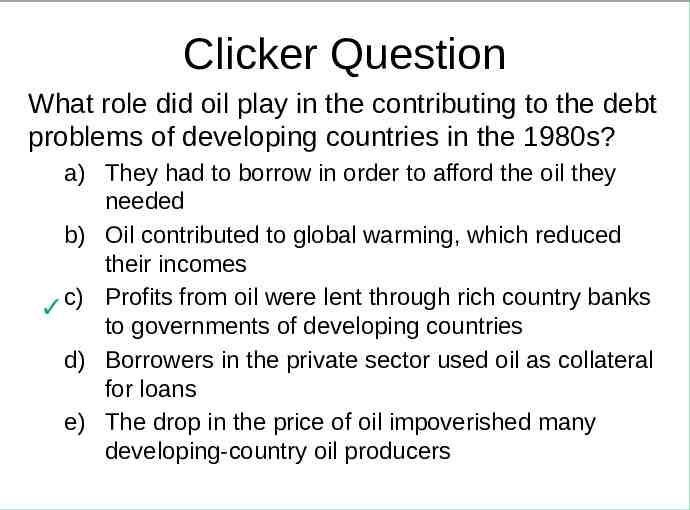
Clicker Question What role did oil play in the contributing to the debt problems of developing countries in the 1980s? a) They had to borrow in order to afford the oil they needed b) Oil contributed to global warming, which reduced their incomes c) Profits from oil were lent through rich country banks to governments of developing countries d) Borrowers in the private sector used oil as collateral for loans e) The drop in the price of oil impoverished many developing-country oil producers
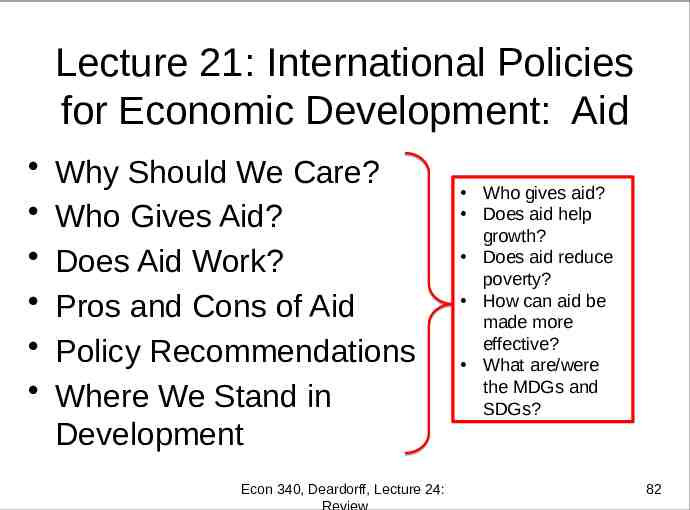
Lecture 21: International Policies for Economic Development: Aid Why Should We Care? Who Gives Aid? Does Aid Work? Pros and Cons of Aid Policy Recommendations Where We Stand in Development Econ 340, Deardorff, Lecture 24: Review Who gives aid? Does aid help growth? Does aid reduce poverty? How can aid be made more effective? What are/were the MDGs and SDGs? 82
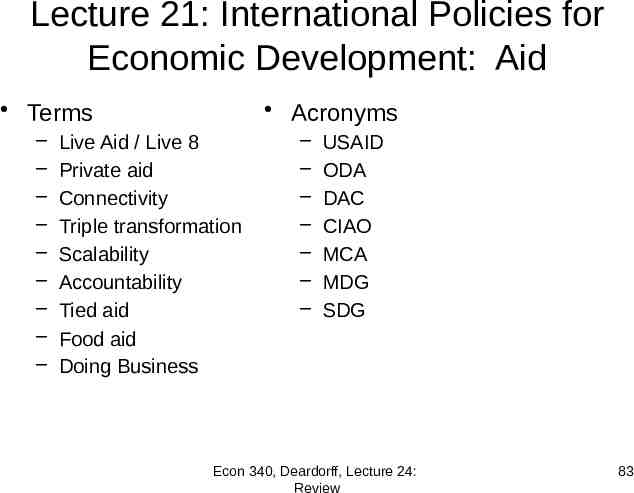
Lecture 21: International Policies for Economic Development: Aid Terms – – – – – – – – – Acronyms Live Aid / Live 8 Private aid Connectivity Triple transformation Scalability Accountability Tied aid Food aid Doing Business – – – – – – – USAID ODA DAC CIAO MCA MDG SDG Econ 340, Deardorff, Lecture 24: Review 83
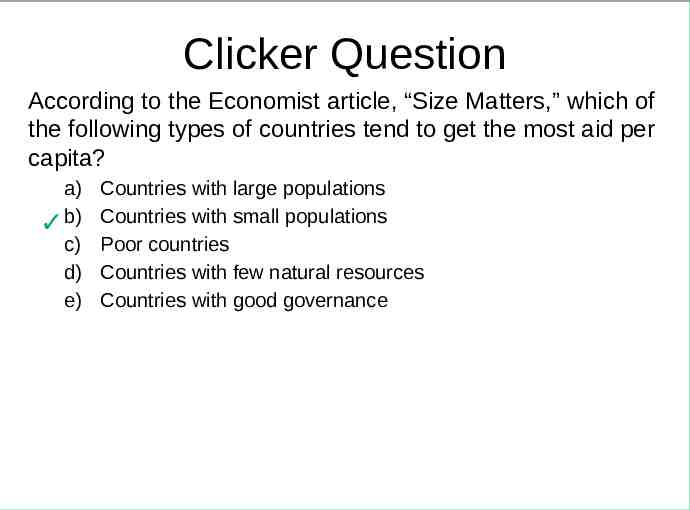
Clicker Question According to the Economist article, “Size Matters,” which of the following types of countries tend to get the most aid per capita? a) b) c) d) e) Countries with large populations Countries with small populations Poor countries Countries with few natural resources Countries with good governance
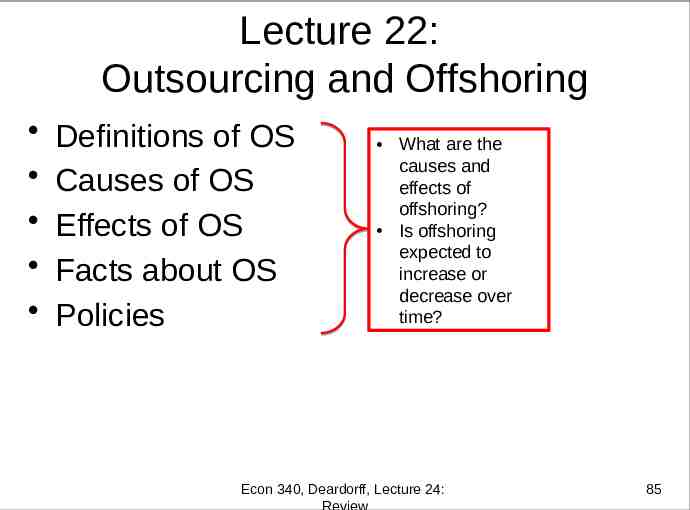
Lecture 22: Outsourcing and Offshoring Definitions of OS Causes of OS Effects of OS Facts about OS Policies What are the causes and effects of offshoring? Is offshoring expected to increase or decrease over time? Econ 340, Deardorff, Lecture 24: Review 85
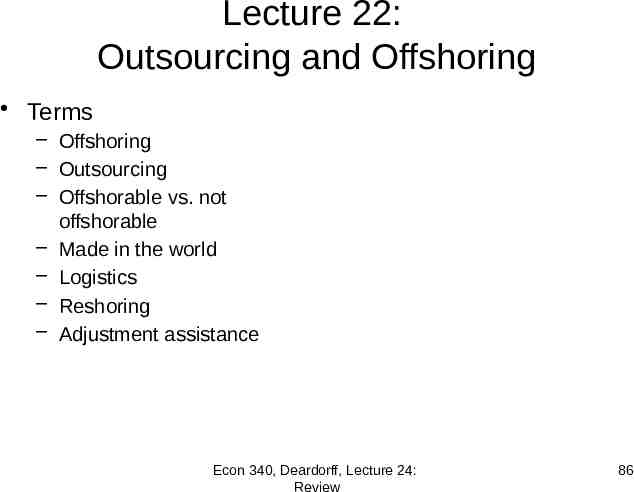
Lecture 22: Outsourcing and Offshoring Terms – Offshoring – Outsourcing – Offshorable vs. not offshorable – Made in the world – Logistics – Reshoring – Adjustment assistance Econ 340, Deardorff, Lecture 24: Review 86
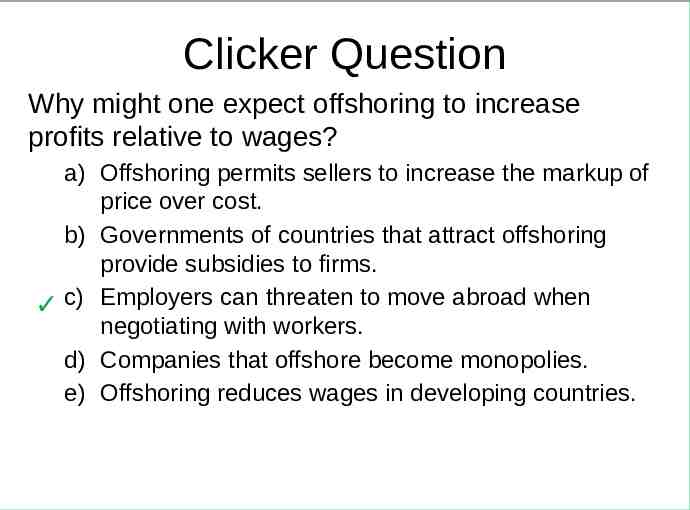
Clicker Question Why might one expect offshoring to increase profits relative to wages? a) Offshoring permits sellers to increase the markup of price over cost. b) Governments of countries that attract offshoring provide subsidies to firms. c) Employers can threaten to move abroad when negotiating with workers. d) Companies that offshore become monopolies. e) Offshoring reduces wages in developing countries.
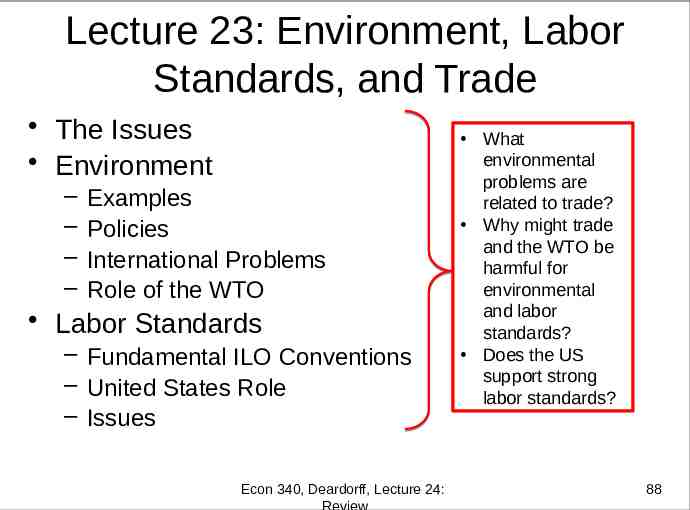
Lecture 23: Environment, Labor Standards, and Trade The Issues Environment – – – – Examples Policies International Problems Role of the WTO Labor Standards – Fundamental ILO Conventions – United States Role – Issues Econ 340, Deardorff, Lecture 24: Review What environmental problems are related to trade? Why might trade and the WTO be harmful for environmental and labor standards? Does the US support strong labor standards? 88
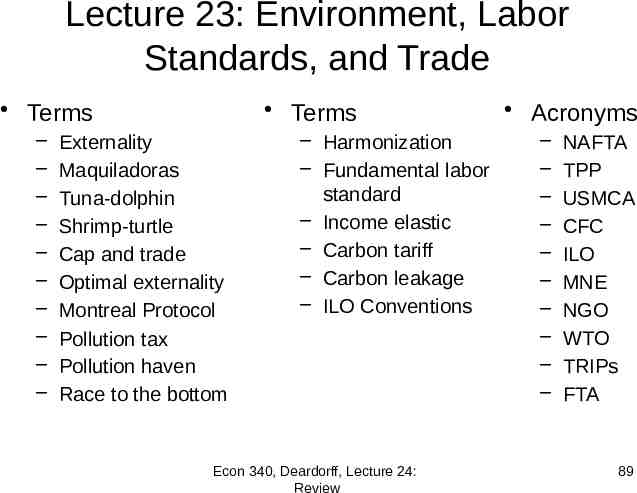
Lecture 23: Environment, Labor Standards, and Trade Terms – – – – – – – – – – Terms Externality Maquiladoras Tuna-dolphin Shrimp-turtle Cap and trade Optimal externality Montreal Protocol Pollution tax Pollution haven Race to the bottom – Harmonization – Fundamental labor standard – Income elastic – Carbon tariff – Carbon leakage – ILO Conventions Econ 340, Deardorff, Lecture 24: Review Acronyms – – – – – – – – – – NAFTA TPP USMCA CFC ILO MNE NGO WTO TRIPs FTA 89
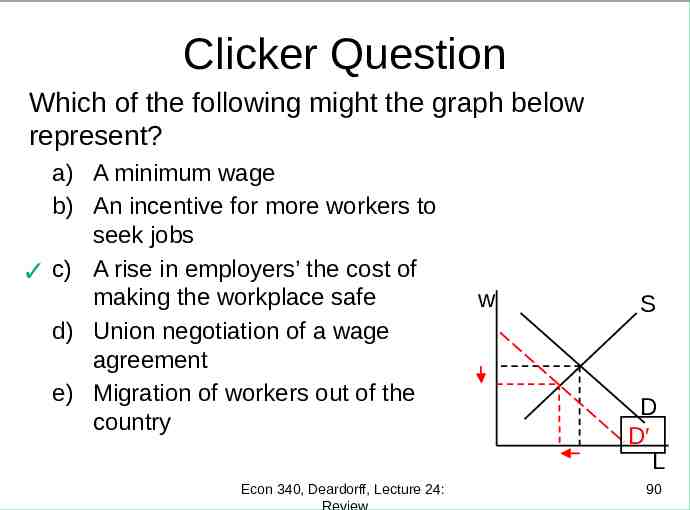
Clicker Question Which of the following might the graph below represent? a) A minimum wage b) An incentive for more workers to seek jobs c) A rise in employers’ the cost of making the workplace safe d) Union negotiation of a wage agreement e) Migration of workers out of the country Econ 340, Deardorff, Lecture 24: Review w S D D′ L 90
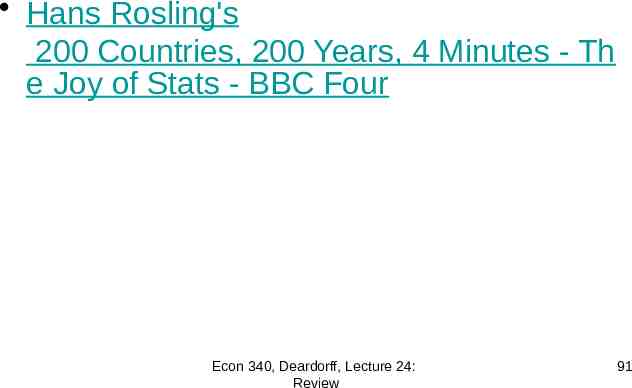
Hans Rosling's 200 Countries, 200 Years, 4 Minutes - Th e Joy of Stats - BBC Four Econ 340, Deardorff, Lecture 24: Review 91

